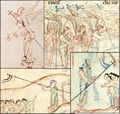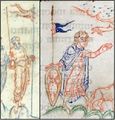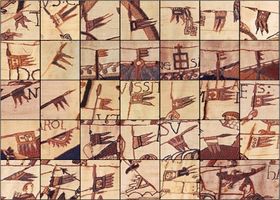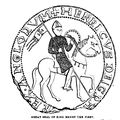Difference between revisions of "Banners"
m (→From Literature) |
m (→Late Roman Draco Standards) |
||
| Line 66: | Line 66: | ||
</gallery> | </gallery> | ||
|Literature = | |Literature = | ||
| − | + | *About Witikind, an adversary of Charlemagne | |
| − | "Hic arripiens signum quod apud eo habebatur sacrum, leonis atque draconis desuper aquilae volantis insignitum effigie ..." | + | :<span style="font-style: italic; color: green">"Hic arripiens signum quod apud eo habebatur sacrum, leonis atque draconis desuper aquilae volantis insignitum effigie ..." [OAKESHOTT 1960:p178] |
| − | + | ||
| − | + | ||
| − | + | ||
|Archaeology | |Archaeology | ||
| Line 78: | Line 75: | ||
<br> | <br> | ||
| + | |||
| + | ==The Viking 'Raven Banner'== | ||
| + | {{evidence | ||
| + | |Art = | ||
| + | <gallery> | ||
| + | File:Banner Bayeux Tapestry 53bjpg | c.1076AD English <br> Bayeux Tapestry | ||
| + | </gallery> | ||
| + | |Literature = | ||
| + | ===The Anglo-Saxon Chronicle=== (Ingram 1912) | ||
| + | *AD 878 | ||
| + | :<span style="font-style: italic; color: green">“And in the winter of this same year the brother of Ingwar and Healfden landed in Wessex, in Devonshire, with three and twenty ships, and there was he slain, and eight hundred men with him, and forty of his army. There also was taken the war-flag, which they called the RAVEN.” [INGRAM 1912]<br> | ||
| + | <br> | ||
| + | Swanton’s translation [SWANTON1996:p.77] of Anglo-Saxon Chronicle E <span style="font-style: italic; color: green">“.. and there the banner which they called ‘Raven', was taken.” </span> It is not however mentioned in Anglo-Saxon Chronicle A. | ||
| + | |||
| + | |Archaeology | ||
| + | |Discussion | ||
| + | }} | ||
| + | |||
==References== | ==References== | ||
Revision as of 12:52, 1 February 2015
| Banners |
|---|
|
More Weapons pages
Banners, standards, flags, gonfanon (gonfalon, guntfano) and pennons (pennants) were commonly adopted by the warriors of the 9th – 12th centuries. This article attempts to briefly outline what the authors currently know about the subject. The style of banner stays surprisingly consistent from the 9th to the 12th centuries and across Western Europe. For this reason we’ve decided to look at all the evidence together rather than, as we usually do, break the evidence into English, Carolingian, etc.
From Art
Pennons
These are triangular flags or streamers.
Banners
These are rectangular flags ending in ‘swallowtails’.
Before 1066AD
- Banner Leiden I Maccabees f.15v.jpg
850-950AD Carolingian
Leiden I Maccabees f.15v - Banner Leiden I Maccabees f.22r.jpg
850-950AD Carolingian
Leiden I Maccabees f.22r - Banner Aachen Liuthar Gospels a.jpg
990AD Ottonian
Aachen Liuthar Gospels - Banner Aachen Liuthar Gospels b.jpg
990AD Ottonian
Aachen Liuthar Gospels - Banner BL Cotton Tiberius C VI f.8v.jpg
1050AD English
BL Cotton Tiberius C VI f.8v - Banner BL Cotton Tiberius C VI f.9r.jpg
1050AD English
BL Cotton Tiberius C VI f.9r
The Bayeux Tapestry
After 1066AD
- Banner Dijon MS14 f.13v a.jpg
1109-1111AD French
Dijon MS14 f.13v - Banner Dijon MS14 f.13v b.jpg
1109-1111AD French
Dijon MS14 f.13v
From Literature
For a full list of banners mentioned in primary sources see Banners from Literature.
Included here are only those quotes that describe the appearance of banners. I have omitted those quotes that just describe the banner as golden.
Bede – Ecclesiastical History of the English People, 731AD
- Osthryth, queen of the Mercians
- "...that there might be a perpetual memorial of the royal character of this holy man [King Oswald], they hung up over the monument his banner of gold and purple." [SELLAR 1907]
The Song of Roland, 1040-115AD
- Verse 39
- "They held Valentian lances, and shield on shoulder wore.
- White and blue and vermilion were the gonfalons they bore." [BACON 1914]
Late Roman Draco Standards
Art
Literature
- About Witikind, an adversary of Charlemagne
- "Hic arripiens signum quod apud eo habebatur sacrum, leonis atque draconis desuper aquilae volantis insignitum effigie ..." [OAKESHOTT 1960:p178]
Archaeology
--
Discussion
"... be the end would have been different. But Harold was struck, and cut down by a Norman sword when William's knights burst through the Huscarles to trample down the Dragon standard and Harold's banner of the Fighting Man." [OAKESHOTT 1960:p.180]
The Viking 'Raven Banner'
Art
- Banner Bayeux Tapestry 53bjpg
c.1076AD English
Bayeux Tapestry
Literature
===The Anglo-Saxon Chronicle=== (Ingram 1912)
- AD 878
- “And in the winter of this same year the brother of Ingwar and Healfden landed in Wessex, in Devonshire, with three and twenty ships, and there was he slain, and eight hundred men with him, and forty of his army. There also was taken the war-flag, which they called the RAVEN.” [INGRAM 1912]
Swanton’s translation [SWANTON1996:p.77] of Anglo-Saxon Chronicle E “.. and there the banner which they called ‘Raven', was taken.” It is not however mentioned in Anglo-Saxon Chronicle A.
Archaeology
--
Discussion
--
References
<nocite> BACON1914 GILES1847 GUMMERE1910 HEWITT1885 LAING1907 OAKESHOTT1960 SELLAR1907 SWANTON2000 TAYLOR1837 </nocite> <biblio force=false>#Template:Bib</biblio>










